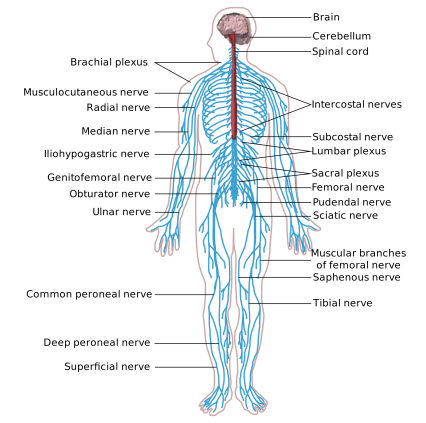Nervous System Structure and Function
Nervous system
The nervous system serves as the chief coordinating agency. Conditions within and outside the body are constantly changing; the nervous system responds to these changes causing the body to adapt itself to new conditions so that balance is maintained.
Organisation of the nervous system:
Structural divisions:
- Central Nervous system
- Includes the Brain and Spinal Cord
- Spinal cord functions
- Conduction of sensory impulses to the brain
- Conduction of motor impulses from the brain
- Reflex response activities
- Spinal cord functions
- Includes the Brain and Spinal Cord
- Peripheral Nervous System
- Includes cranial nerves which carry impulses to and from the brain and spinal nerves which carry impulses to and from the spine
Functional divisions:
- Somatic (voluntary) nervous system
- Function – supplies skeletal muscle
- Visceral (involuntary) nervous system
- Function – supplies smooth muscle, cardiac muscle, glands
- Autonomic nervous system – regulates involuntary motor nerves during flight, fight, freeze conditions
- Sympathetic system
- Adjusts response to stressful situations
- Parasympathetic system
- Adjusts response when stressful situations have passed
- Sympathetic system
- Autonomic nervous system – regulates involuntary motor nerves during flight, fight, freeze conditions
- Function – supplies smooth muscle, cardiac muscle, glands
Functional Structures:
- Neuron – nerve cell
- Sensory – carries impulses towards the central nervous system
- Motor – carries impulses away from the central nervous system
- Nerve impulse
- Electric current that spreads along a nerve fibre
- Synapse
- Junction between neurons where a nerve impulse is transmitted from one neuron to the next
- Nerve
- Bundle of nerve cell fibres outside the Central Nervous System
- Reflex Arc
- Pathway through the nervous system